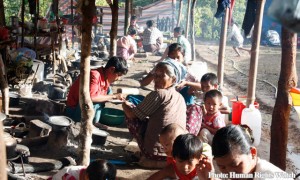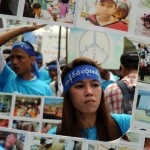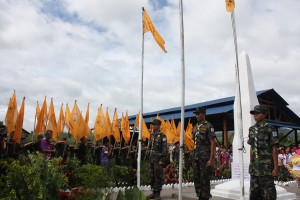Posts Tagged ‘Ceasefire’ (57 found)
Humanitarian Aid Denied
 This week’s ceasefire talks between the Kachin Independence Army (KIA) and the Burma Government are a positive step in what has been a devastating conflict rife with human rights abuses, displacement and death. While these talks have been praised by both international governments and the United Nations, there remain many obstacles to a sustainable political settlement and lasting peace.
This week’s ceasefire talks between the Kachin Independence Army (KIA) and the Burma Government are a positive step in what has been a devastating conflict rife with human rights abuses, displacement and death. While these talks have been praised by both international governments and the United Nations, there remain many obstacles to a sustainable political settlement and lasting peace.
Hostilities are still occurring and combatants continue to resupply, increasing tensions in an already frail situation. One positive step that has been taken is the allowance of aid to those in KIA-held areas affected by the conflict. Though it should be stated that the size and scope of this aid needs to conform to the needs identified on the ground and if all of those affected will receive adequate help is yet to be determined. It is estimated that over 160,000 people have been displaced over the course of fighting. These people are living in makeshift camps and without emergency aid are at great risk of humanitarian tragedy […]
Karen in Europe Calls on the EU to Take Stronger Actions on the Attacks in Kachin State
Karen communities in Europe condemn the Burmese Army’s continuous attack against the Kachin people and calls on the Thein Sein government to stop making empty promises of ceasefire, and commit to a genuine nationwide ceasefire and genuine dialogue leading to a political solution in Burma […]
• • •Press Release on the Ceasefire Announcement at the Laja Yang by the Burmese Government on 18th January 2013
1). The Burmese army continues unjust military offensives in Laja Yang and other parts of Kachinland despite the Burmese government announcing a one-sided deceptive ceasefire applied only to Laja Yang area […]
• • •Statement of Kachin Independence Organization
It has been noted that the Myanmar Government’s Media Department issued a statement on 18th January 2013. In this statement they announced that Government troops would cease their offensive around the Laja Yang area at 6:00am, 19th January 2013 […]
• • •Steps Towards Peace: Local Participation in the Karen Ceasefire Process
During the ten months since a preliminary ceasefire agreement was reached between representatives of the Government of the Union of Myanmar and the Karen National Union (KNU),[1] negotiators from the two parties have met twice, most recently on September 3rd and 4th, aiming to build trust and progress towards a code of conduct that will set guidelines as to how the armed actors must operate towards each other.[2] As the details of this document have not yet been made public,[3] this moment presents an opportunity to consider what impact the ceasefire has had for villagers in eastern Burma in the last ten months and, based on their perspectives, to suggest further steps that are still needed to ensure sustainable peace.
• • •Position Statement of the KNU Central Standing Committee Special Emergency Meeting
On October 25 and 26, 2012 the Karen National Union (KNU) Central Standing Committee (CSC) held a special emergency meeting at Lay Wah, in Pa-an District, and efficaciously resolved the problems, which had been brewing within the KNU […]
• • •Peace Day Protest Goes Ahead in Rangoon
 In the largest popular demonstration since the monk-led 2007 Saffron Revolution, hundreds of protesters marched through Rangoon on Friday to mark International Peace Day and to demand an end to the ongoing conflicts in Burma’s ethnic regions. In a defiant move rarely seen in Burma, protesters gathered in front of City Hall on Friday morning before setting off in lines through the busy streets of Rangoon to their planned rendezvous, Inya Lake, where they say they will hold a prayer service for national peace in the evening.[…]
In the largest popular demonstration since the monk-led 2007 Saffron Revolution, hundreds of protesters marched through Rangoon on Friday to mark International Peace Day and to demand an end to the ongoing conflicts in Burma’s ethnic regions. In a defiant move rarely seen in Burma, protesters gathered in front of City Hall on Friday morning before setting off in lines through the busy streets of Rangoon to their planned rendezvous, Inya Lake, where they say they will hold a prayer service for national peace in the evening.[…]
ေကအဲန္ယူ-ကရင္အမ်ဳိးသားအစည္းအရံုး၏ အပစ္အခတ္ရပ္စဲေရးဆိုင္ရာ ေတြ႕ဆံုေဆြးေႏြးေရး တတိယခရီးစဥ္ သတင္းထုတ္ျပန္ေၾကညာခ်က္
ေကအဲန္ယူ-ကရင္အမ်ဳိးသားအစည္းအရံုးဘက္မွ အေထြေထြအတြင္းေရးမွဴး ေနာ္စီဖိုးရာစိန္ႏွင့္ ေကအဲန္အယ္လ္ေအ တြဲဘက္စစ္ေရးခ်ဳပ္ ဗိုမွဴးခ်ဳပ္ စရွာတုေဝၚ ဦးေဆာင္သည့္ ကိုယ္စားလွယ္ (၉) ဦးႏွင့္ ျပည္ေထာင္စုသမၼတ ျမန္မာႏိုင္ငံေတာ္ အစုိးရတို႕၏ ျပည္ေထာင္စုအဆင့္ ေတြ႕ဆံုေဆြးေႏြးပြဲကို […]
• • •Continued Conflict Overshadows Karen Martyrs Day
 While Karen people around the world celebrated the 62nd Karen Martyrs Day last week to honour those who have died for the Karen cause, the fragility of the ceasefires with various groups remains tenuous as the Burma government continues to neglect the root causes of the conflicts. Denial and refusal to face up to human rights abuses while neglecting substantial political dialogue with the ethnic armed groups is not a sustainable solution to decades of conflict. Even during peace talks between the Government and the Karen National Union (KNU) in Myawaddy, eastern Karen State on August 7th, clashes between the government’s Border Guard Force and the Karen National Liberation Army (KNU’s armed wing) were occurring in other parts of the Karen region […]
While Karen people around the world celebrated the 62nd Karen Martyrs Day last week to honour those who have died for the Karen cause, the fragility of the ceasefires with various groups remains tenuous as the Burma government continues to neglect the root causes of the conflicts. Denial and refusal to face up to human rights abuses while neglecting substantial political dialogue with the ethnic armed groups is not a sustainable solution to decades of conflict. Even during peace talks between the Government and the Karen National Union (KNU) in Myawaddy, eastern Karen State on August 7th, clashes between the government’s Border Guard Force and the Karen National Liberation Army (KNU’s armed wing) were occurring in other parts of the Karen region […]
New Peace Committee Offers Little Hope to Ethnic People
Last week, the Thein Sein government formed its new union-level peace committee comprised of a central committee and a working committee. Although the formation of the committee looks very encouraging to investors and gives another reason for Western countries to further lift sanctions, it gives little hope to the people of Kachin State who have lost both their homes and their faith in the President after he unsuccessfully and repeatedly ordered the Burma Army to halt offensives in Kachin State.
As with most of the reforms announced, much secrecy surrounds the new peace committee. There is little transparency regarding the process of its establishment and mandate. Apart from names of the central committee members, disclosed by an unofficial source, there is no other official information available about the central and working committees. The central committee headed by President Thein Sein and the 52-member working committee includes the Vice-Presidents, heads of States and Divisions, Members of Parliament, Ministers and the Commander-in-Chief of the armed forces […]
• • •








 All posts
All posts